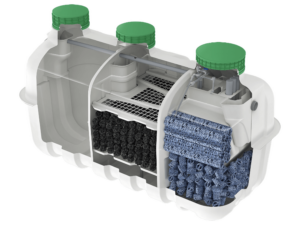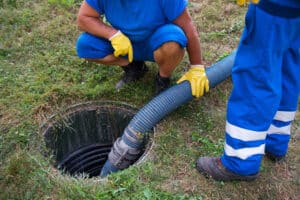New York State takes the management of septic systems seriously due to the potential environmental impacts and public health concerns associated with improperly maintained systems. The state has established a comprehensive regulatory framework to govern the installation, maintenance, and operation of septic systems. As a property owner in New York, it’s vital for you to understand these regulations to ensure your septic system is not only compliant but also contributes to the well-being of the community and environment.

Navigating the regulatory landscape can be challenging, but it’s necessary because septic systems play a crucial role in waste disposal, especially in areas not served by municipal sewer systems. By adhering to the design and installation requirements, maintaining your system appropriately, and staying informed about the latest advancements in septic technology, you can avoid common pitfalls and potential penalties. Moreover, knowing who to contact for information and resources ensures you can make informed decisions about your septic system needs.
Key Takeaways
- Understanding New York State’s septic system regulations ensures compliance and environmental safety.
- Proper maintenance and operation are crucial for the longevity and effectiveness of your septic system.
- Access to information and resources helps you stay informed about septic system management in New York State.
New York State Septic System Overview

As you explore the regulations surrounding septic systems in New York State, it’s crucial to understand the framework that governs wastewater treatment and environmental conservation, as well as the challenges that come with ensuring minimal environmental impact.
Historical Context
New York State has long recognized the need to address the handling of wastewater to protect its diverse environments, from the Adirondack Mountain ranges to the bustling streets of New York City. Historically, the state has implemented septic system regulations to manage how both urban and rural areas deal with wastewater. This has involved periodic revisions to stay aligned with evolving environmental conservation efforts and public health standards.
Current Challenges
Currently, New York faces intrinsic challenges related to septic systems because of aging infrastructure and increased environmental scrutiny. Homeowners are often required to upgrade their systems to comply with modern standards, which can be a significant financial undertaking. Additionally, environmental conservation efforts demand that systems operate within guidelines that prevent groundwater contamination and protect local ecosystems. State-led initiatives are in place to mitigate the environmental impact of septic systems, but consistent enforcement and public education remain paramount to these efforts’ success.
Regulatory Framework

Your understanding of New York State’s septic system regulations is vital for compliance and environmental protection. These rules are chiefly governed by the State Sanitary Code, specifically Appendix 75-A, and are enforced by the Department of Health.
State Sanitary Code & Appendix 75-A
The State Sanitary Code serves as the fundamental body of law that oversees public health matters, under which Appendix 75-A falls. This appendix details the standards for individual household sewage treatment systems, defining their construction, operation, and maintenance. Under Appendix 75-A, you are required to follow specific guidelines that ensure your septic system does not adversely affect public health or the environment.
Key components of Appendix 75-A include:
- Siting and Construction: Specifications for how and where to construct your septic system.
- Capacity and Design: Standards for ensuring your system can effectively treat the volume of wastewater your household produces.
- Operation and Maintenance: Guidelines to guarantee the ongoing functionality of your septic installation.
Compliance with Appendix 75-A is enforced by local health departments, ensuring that these systems are not only built but also maintained in a manner that aligns with public health objectives.
Department of Health Regulations
In tandem with the State Sanitary Code, the Department of Health (DOH) propounds regulations that safeguard public welfare by overseeing septic system standards. The DOH works closely with the New York State Department of Environmental Conservation (DEC), which manages broader environmental considerations, ensuring water quality and ecological health are not compromised.
The DOH’s regulations stipulate:
- Permit Requirements: Before you install or modify a septic system, you’re expected to obtain a permit.
- Inspection Compliance: Regular inspections are mandatory to ensure ongoing adherence to health standards.
- Certification of Professionals: Septic system installers and service providers must be certified to affirm their adherence to state regulations.
Both the Sanitary Code with Appendix 75-A and DOH regulations aim to prevent environmental contamination and protect public health through rigorous and methodical waste treatment systems’ management. It is your responsibility to ensure that any work done on septic systems aligns with these regulatory guidelines.
Design and Installation Requirements

In New York State, stringent regulations guide the design and installation of septic systems to protect water quality and public health. You must adhere to specific criteria to ensure your septic system functions effectively and complies with environmental standards.
Septic System Design Basics
Your septic system design must meet minimum standards for size, location, and construction. Conventional septic systems require at least 1.2 meters of unsaturated soil for adequate treatment of effluent. This may mean that alternative septic system designs, such as raised bed or septic mound systems, are necessary in areas with less available soil depth. For these types of systems, specific raised bed septic design specifications or septic mound design specifications must be followed to ensure that they can effectively treat and disperse wastewater in the absence of adequate natural soil conditions.
Design Standards:
- Minimum soil depth: 1.2 meters for conventional systems.
- Raised bed and mound systems: additional specifications apply.
- Drainfield sizing: based on the number of bedrooms and soil percolation rate.
- Leach field: designed for optimum wastewater dispersion and treatment.
Installation Practices
Installation of your septic system is a critical phase that determines its long-term viability. Proper installation practices help prevent system failure and environmental contamination. It’s essential that you follow New York State’s guidelines for siting and constructing the necessary components. This includes positioning the drainfield away from water sources and ensuring all elements of the system are level and properly connected. If you’re installing an alternative system, extra precautions are needed to meet the unique design requirements of these systems and may involve specialized techniques or materials.
Installation Checkpoints:
- System components must be level.
- Compliance with state guidelines during siting and construction.
- Required permits acquired before installation begins.
Maintenance and Operation
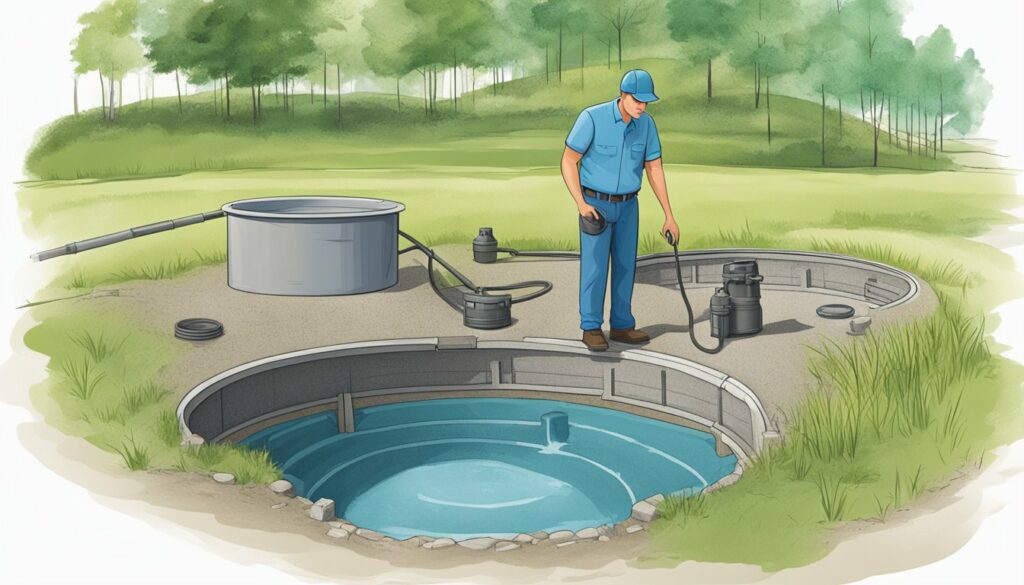
Proper maintenance and operation of your septic system are crucial for its longevity and functionality. Keeping a regular maintenance schedule and following best practices in operation can prevent costly repairs and environmental damage.
Routine Maintenance
Septic Tank: Your septic tank requires periodic inspection and pumping to ensure it functions correctly. Typically, you should have your tank inspected every one to three years and pumped every three to five years. However, actual frequency will vary depending on the size of your tank and household usage.
Filters: Make sure the filters are clean and intact to prevent solids from entering the drainfield. Filters should be checked and cleaned as per manufacturer’s recommendations or at least annually.
Operational Best Practices
Water Efficiency: Utilize water-efficient fixtures to reduce the amount of wastewater entering your septic system. Excessive water usage can overload the system, leading to potential failures.
Waste Disposal: Be mindful of what you flush or put down the drain. Do not dispose of grease, hazardous chemicals, or non-biodegradable materials as they can disturb the biological balance within the tank or clog your system.
Remember, regular maintenance and responsible operation of your septic system preserves its integrity and protects the environment.
Environmental and Health Considerations

New York State’s septic system regulations are designed with stringent measures to safeguard your health and protect the environment. These measures specifically aim to preserve vital water sources and mitigate the risk of contaminant leaching into groundwater, with a focus on mitigating nitrogen and phosphorus pollution.
Protection of Watersheds & Water Bodies
Your watershed is the lifeblood of your community’s water supply. The Environmental Protection Agency (EPA) underscores the importance of protective measures within these zones. In New York, septic system regulations are crafted to ensure that effluent discharge does not impair local water bodies by exceeding thresholds of nitrogen and phosphorus levels, which are keys to preventing eutrophication—a condition that can devastate aquatic ecosystems.
Preventing Groundwater Contamination
The integrity of your groundwater is paramount. It is your invisible yet vital resource beneath the Earth’s surface. Septic systems in New York are therefore regulated to minimize the introduction of pathogens and chemicals into your groundwater. The state mandates that systems are properly located, designed, and maintained. The regulations follow best practices acknowledged by the EPA to prevent health risks associated with waterborne pathogens and contamination, ensuring your access to clean and safe groundwater.
Site Evaluation Processes
When installing a septic system in New York State, site evaluation plays a crucial role. This evaluation ensures that the system will function properly, protect groundwater, and adhere to environmental regulations. The two main components of the site evaluation process are the Soil and Site Assessments and Percolation Testing.
Soil and Site Assessments
Your first step in the evaluation process involves assessing the land where the septic system will be installed. This includes a soil evaluation to determine the soil’s texture, structure, and consistency. Professionals use this data to predict how well the soil will filter and absorb wastewater. The evaluation may direct you to guidance on septic system performance in sloping terrains for land with varying topographies. Such insights help ensure suitability for septic system placement in compliance with state guidelines.
Percolation Testing
Next, you’ll need to conduct a percolation test (often referred to as a “perc test”), which provides critical percolation test results. This test measures the rate at which water drains through the soil. Your perc test results indicate the soil’s ability to handle effluent from the septic system. Fast-percolating soils may need an alternative system design, as they can allow contaminants to reach groundwater quickly. Conversely, slow-percolating soils might require a larger drain field. Proper percolation testing is a necessary step for determining the design and feasibility of your septic system, to ensure long-term functionality and compliance with environmental standards.
On-Site Inspections and Enforcement
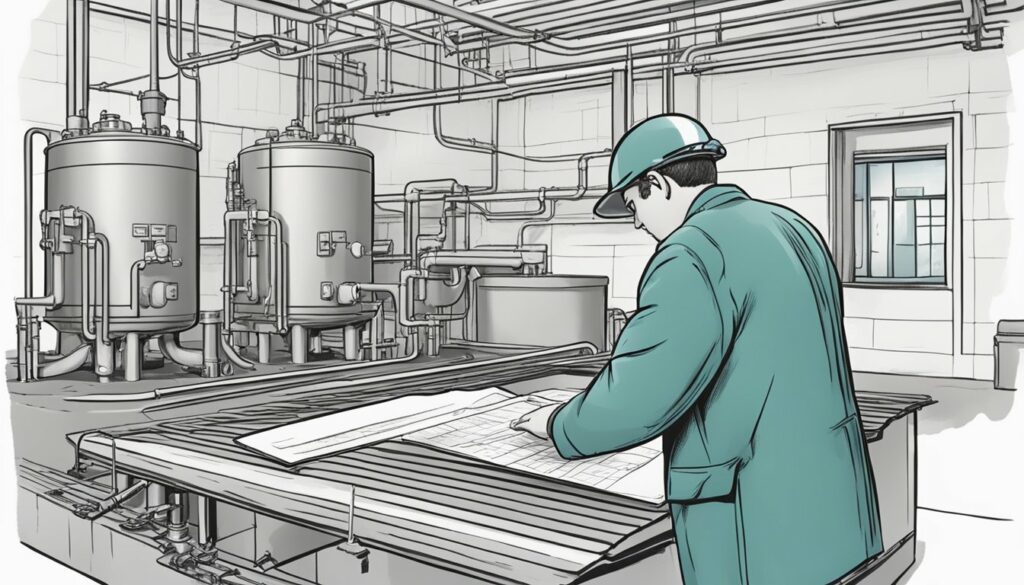
Your local health department plays a pivotal role in the oversight of septic systems. When issues arise, enforcement actions are critical to maintaining environmental safety and public health.
Role of Local Health Departments
Local health departments are at the forefront of on-site inspections for septic systems. These inspections are essential to ensure that systems are installed correctly and functioning properly. Regular inspections include checking septic tanks for structural integrity and ensuring that leach fields are effectively treating wastewater. Should your system not meet the required standards, the local health department has the authority to mandate necessary repairs or system upgrades.
Complaints and Enforcement Actions
When complaints about a septic system are filed, typically concerning overflows or contamination, local health departments become involved to investigate the issue. If a violation is found, enforcement actions such as fines or mandatory fixes come into play. Remember, the goal of these actions is to protect community health and the environment, not to punish homeowners. In severe cases, non-compliance can lead to legal action, underscoring the importance of addressing septic system concerns promptly and effectively.
Certification and Training

In New York State, the regulations surrounding septic systems emphasize the importance of certification and training for individuals involved in the installation and design of these systems. This ensures that these crucial tasks are executed with a high degree of expertise and adherence to current standards.
Accreditation for Installers and Designers
To work as a septic system installer or designer in New York, you need to obtain proper certification. This certification process involves completing specified training courses and passing a state-recognized exam. For example, Suffolk County in New York requires professionals to earn a Certificate of Conformance which indicates that the individual has met all the necessary regulations and training requirements. The certification must be renewed periodically, which may require additional training to stay updated on the latest regulations and technologies.
Educational Programs & Outreach
The state of New York has educational programs designed to keep you, the installer or designer, informed about the latest standards in septic system technology. These educational programs are often held at dedicated training centers. As an example, professionals from states like Florida to New York have benefitted from advanced training and certification courses aimed at enhancing their expertise. Regular attendance at these training sessions is crucial for maintaining your certification and ensuring that the septic systems you work on are up to the highest standards.
These programs often cover topics such as site evaluation, septic system design, installation practices, and maintenance. You can expect to engage with courses that are both practical and theoretically driven, aimed at providing a comprehensive education in all aspects of on-site wastewater management.
Alternative and Advanced Systems
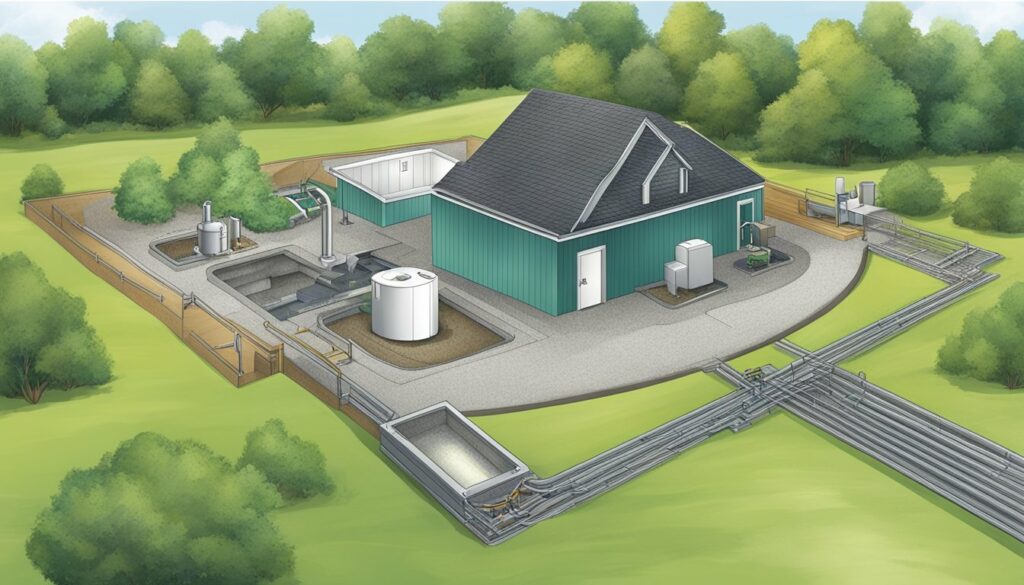
Your understanding of septic system regulations in New York State would benefit greatly from exploring the latest methods for waste management—alternative and advanced systems. These innovative options tailor solutions for varying site conditions and environmental demands.
Alternative System Types
Alternative septic systems are designed for use in situations where traditional methods may not be suitable due to soil conditions or environmental concerns. One prevalent type is the intermittent sand filter system, which filters effluent through sand before it reaches the soil. This can be beneficial in areas with high water tables or insufficient soil for standard septic systems. In addition:
- Evaporation/Transpiration systems are effective in arid regions, using natural evaporation and plant transpiration to treat sewage.
- Holding tanks serve as a temporary solution, storing waste until it can be pumped out and transported to a treatment facility.
- Raised septic systems, often necessary in areas with poor drainage, elevate the leach field above ground level to enhance filtering and prevent saturation.
Advanced Treatment Technologies
Advanced treatment technologies take waste processing to the next level, improving the quality of effluent before it disperses into the environment. Designs such as:
- Aerobic Treatment Units (ATUs): Introduce oxygen to break down waste more thoroughly than traditional systems.
- Septic Mound Systems: Utilize an elevated drain field with additional layers of soil and sand to treat effluent in places with shallow soil depths.
These systems require more management but offer higher performance, particularly in sensitive ecological areas where traditional absorption systems may falter. Your choice should consider maintenance commitments, cost implications, and compliance with local regulations.
Construction and Post-Construction

In New York State, you must navigate a stringent regulatory landscape to ensure your septic system adheres to rigorous environmental and public health standards. During construction and post-construction phases, compliance with state mandates for design approval, construction permits, and wastewater treatment standards is critical.
Construction Permits & Approval Process
Before any septic system construction begins, you must obtain the proper permits. This process starts with submitting a detailed design for approval to your local health department. Your design must meet specific wastewater treatment standards to protect groundwater and surface water from contamination. Once your design receives approval, you are issued a construction permit, allowing you to commence building the septic system in accordance with the approved plans.
Post-Construction Inspections
After construction, a crucial phase is the post-construction inspection. This inspection is conducted to ensure the septic system was constructed as per the approved design and is functioning appropriately. You should expect an inspector to examine components like the tank, distribution box, and leach field for compliance with the state’s wastewater treatment standards. Successful completion of this inspection is necessary before the system can be put into use.
Consumer Information and Resources

As a homeowner in New York State, understanding septic system regulations is critical for maintaining your property and protecting the environment. Access to accurate information and resources can guide you through proper septic system upkeep.
Homeowner Education
Your Knowledge Base: You are encouraged to familiarize yourself with the mission of the Center for Environmental Health which aims to safeguard public health by regulating septic systems. Articles published by certified authors offer educational material that covers maintenance requirements and the environmental impact of septic systems.
- Town Hall Meetings: Regular sessions are commonly held for residents by local town officials, where you can obtain information about the latest septic system regulations and available tax incentives for compliant upgrades.
- Workshops: Some communities organize free workshops that deliver practical advice and information on septic system care tailored specifically to the New York State guidelines.
Professional Consultation & Services
Finding Expert Help: When you require assistance with your septic system, consulting with professional septic consultants and engineers is advisable. They can provide detailed evaluations and customized solutions for your septic needs.
- Better Business Bureau: Verify the credibility of service providers through the Better Business Bureau to ensure they are reputable and hold the proper certifications.
- U.S. Septic Authorities Recommendations: For more technical or regulatory queries, referencing guidelines and recommendations from U.S. septic authorities can provide clarity and help you adhere to the legal requirements.
Professional Services List:
| Service Type | Description |
|---|---|
| Inspection | Assess the condition and functionality of your septic system. |
| Maintenance | Scheduled cleaning and repair services. |
| System Upgrades | Installations that meet current regulatory standards. |
Remember to keep a record of all maintenance activities and consultations for reference and compliance verification.
Frequently Asked Questions

In this section, you’ll find specific information about septic system regulations in New York State. These FAQs aim to clarify the requirements and processes that homeowners and builders need to know.
What are the minimum requirements for septic system installation in New York State?
The minimum requirements for septic system installation in New York State include obtaining a permit, adhering to local health department standards, and ensuring the system is designed by a licensed professional. Systems must be installed at a suitable distance from water sources to prevent contamination.
How does the New York State Septic System Replacement Program work?
The New York State Septic System Replacement Program offers funding assistance to replace aging or failing septic systems. Qualified homeowners can receive financial aid to cover the costs associated with system upgrades necessary to meet current health and environmental standards.
What regulations govern the discharge of greywater in New York State?
New York State mandates that all greywater, which is wastewater from domestic activities except for toilet waste, must be treated and disposed of through an approved septic system or public sewage treatment facility, ensuring it does not contaminate surface or groundwater.
What steps must homeowners take to comply with New York’s septic system code requirements before installation?
Homeowners must first obtain a permit from their local health department. Then, a state-licensed engineer or architect must design the septic system according to New York State codes. Finally, the system must be inspected and approved by the local health department following installation.
Are there specific legal requirements for selling a property with a septic system in New York?
When selling a property with a septic system, New York State requires that you disclose the condition of the system to the buyer. You may also need to provide proof of maintenance and the results of an inspection, depending on local ordinances.
In New York State, are there restrictions on the distance between a septic system and a residence?
Yes, New York State regulations stipulate minimum separation distances between a septic system and any residence, wells, waterways, and property lines. These distances vary by locality and are designed to protect residents from potential hazards associated with system failures.




